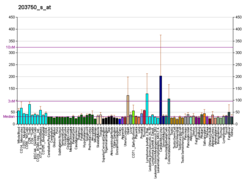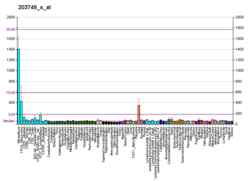レチノイン酸受容体α
レチノイン酸受容体α(英: retinoic acid receptor alpha、略称: RARα)またはNR1B1(nuclear receptor subfamily 1, group B, member 1)は、ヒトではRARA遺伝子にコードされる核内受容体である[5][6]。
RARA遺伝子は17番染色体17q21.2に位置し、転写因子として機能する核内ホルモン受容体をコードする。レチノイン酸受容体(RAR)はRARαの他に、RARβ、RARγの2種類が存在する[7][8]。
機能
レチノイドシグナルは、レチノイン酸受容体(RAR)とレチノイドX受容体(RXR)の2種類の核内受容体ファミリーからなるRXR/RARヘテロ二量体によって伝達される。リガンドが存在しない場合には、DNAに結合したRXR/RARαはコリプレッサーであるNCOR1、NCOR2(SMRT)、そしてヒストンデアセチラーゼをリクルートすることで転写を抑制する。リガンドが複合体に結合すると、コンフォメーション変化が生じてコアクチベーター、ヒストンアセチルトランスフェラーゼ、基本転写装置のリクルートが可能となる[8]。RARαはビタミンA誘導体であるレチノイン酸と相互作用し、細胞成長、分化、胚発生時の器官形成に重要な役割を果たす[8][9]。
臨床的意義
レチノイン酸シグナルは、初期胚発生時のいくつかのシグナル伝達経路と関係している。レチノイン酸は体軸の形成に関与しており、対称性を確立する。また、レチノイン酸はプロニューラル因子であるニューロゲニン2(Neurog2)の発現を調節することで神経分化に影響を与える。レチノイン酸は心臓形成にも影響を与え、具体的には心房の形成に関与している。また、膵臓、腎臓、肺、四肢の発生にも関与している[9]。
RARA遺伝子の再配置を伴う染色体転座は、急性前骨髄球性白血病(APL)の主要な特徴である。最も高頻度でみられる転座はt(15,17)(q21;q22)であり、RARA遺伝子がPML遺伝子と融合している[10]。
相互作用
RARαは次に挙げる因子と相互作用することが示されている。
リガンド
アンタゴニスト
- BMS-189453(非選択的)
- YCT529 (RARα選択的)
出典
関連文献
関連項目
- レチノイン酸受容体
- レチノイドX受容体
- 急性前骨髄球性白血病







